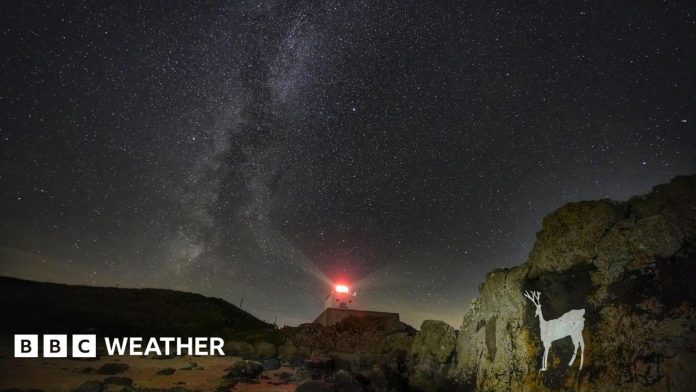
Inspired by the recent total lunar eclipse? There are more celestial events to look out for this autumn as the nights start to draw in.
Whilst meteorological autumn begins every year on the same date – 1 September – the start of astronomical autumn varies with the date of the equinox.
This is when Sun is directly above Earth’s equator resulting in almost equal time of the length of day and night.
This year, the equinox falls on 22 September at 19:20 BST.
From this point the light will fade faster in the evenings and the nights will become longer.
By the end of November, we will have lost around five to six hours of daylight on average compared to the end of August. Check your local sunset and sunrise times here.
And there is plenty to look out for during those darker nights.
Bright Saturn

A NASA image of Saturn and its distinctive rings
The day before the equinox (21 September), Saturn will be at its closest to earth and will appear at its brightest.
That’s because it will be in ‘opposition’, meaning that it is located directly opposite the Sun so will be fully illuminated and appear at its biggest and brightest.
This is not an unusual event but it is one of the easiest and most satisfying planets to identify with its famous rings.
Visible to the naked eye, it will look like an non-twinkling star in the constellation of Pisces. You will need a telescope to spot the rings however.
It will remain in the evening sky for the rest of the year.
Orionid meteor shower

There could be around 25 meteors an hour during the peak of the Orionids
The Orionid meteor shower takes place between 2 October and 7 November, peaking for about a week around the 22 October.
The Orionids are fast-moving meteors with long steaks of light and originate from the well-known Halley’s Comet.
Look towards the constellation of Orion, stay away from city lights and let your eyes adjust to the dark before trying to spot the Orionid meteors. The peak coincides with the new moon so viewing conditions will be ideal with no moonlight pollution.
Draconids and Taurids meteor showers
Less spectacular this year will be the Draconid and Taurid meteor showers.
The Draconids peak on the night of 8 October, coinciding with the full Moon which will make the meteors much harder to spot.
Likewise the peak of the Taurids on 12 November, which only produces around 5 meteors an hour, will be affected by light pollution from a waxing gibbuous Moon with an illuminated surface of 84%.
Supermoon

The full Moon in perigee rising above Glastonbury Tor in December 2024
The Moon has an elliptical orbit and when it is at its closest point to the Earth we say that it is in perigee.
When the perigee coincides with a full Moon it is known as a supermoon. It can appear up to 14% bigger and 30% brighter than when it is further away from the Earth.
The next supermoon will occur on 5 November, with another to follow on 4 December.
Clear or cloudy?
Cloudy skies have of course scuppered many a great night of stargazing.
In order to see all these celestial events we will need clear skies.
With our jet stream currently across the south of the UK and low pressure dominating, the weather has been unsettled and mixed of late.
Keep checking the full monthly outlook from BBC Weather here.

